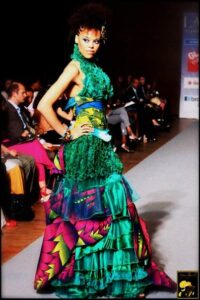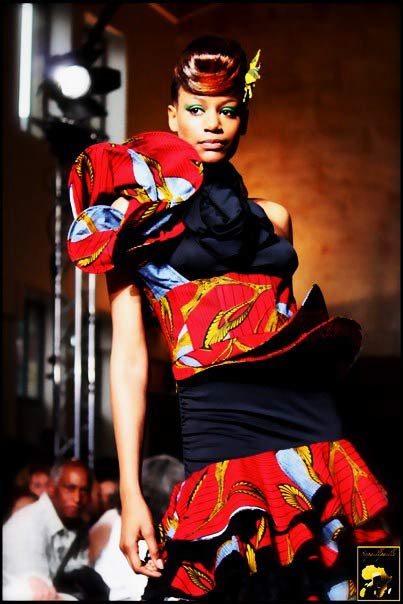by Fanele Chester. First posted in Dunia Magazine – print (Issue 2)
Eva Gabarra’s success in fashion is a recurrent tale of sacrifice, hard-work, risk taking, and talent. The Senegalese native was a private-school teacher for three years, a secretary for another five years before fully dedicating herself to her true love of fashion design. The beginning was not all glamor either; Eva began by opening a boutique in Senegal for French label, RESSILE, in 2000. Five years later, experience in hand and more creative juices flowing, she went on to launch her line Eva Gabarra Couture in 2005. The next five years, fueled by motivation and seized opportunities, the fashion house was propelled to Paris and Dakar. Eva’s big break came in 2009 during the VLISCO Concours de Jeunes Créateurs 2009 in Paris. This was her launch-pad into international recognition.
Why is Eva Gabarra’s story so interesting? It is simply because she is representative of the nature of  contemporary fashion in Africa. First, her designs know no boundaries. Although the inspiration is decidedly African, her designs appeal to the modern and cosmopolitan woman especially one who travels or lives abroad, and has a style that is influenced by her international environment. In the end, you get designs with a contemporary regality, made for a confident woman.
contemporary fashion in Africa. First, her designs know no boundaries. Although the inspiration is decidedly African, her designs appeal to the modern and cosmopolitan woman especially one who travels or lives abroad, and has a style that is influenced by her international environment. In the end, you get designs with a contemporary regality, made for a confident woman.
Second, the epicenter of African fashion is not in Africa. Western popular fashion typically converges in four cities: London, Paris, New York and Milan. Coincidentally, African fashion is following the same pattern, taking root in Johannesburg, Dakar, Paris and New York; there is no one epicenter. EGC’s base in Dakar and strong presence in Paris is testament to this. There are social and economic ties to the cities in which African fashion has established itself, however more revealing are the ways in which Africans continue to progress both in our native countries and our countries of residence. What you get in the end is a resultant fusion of both cultures.
 The success of African designers lies in manipulating this tension between what is African and what is Western, and turning this into a form of creative expression that women and fashion lovers can appreciate. Eva’s fabrics of choice include silk, muslin, organza, lace, sequins with a backdrop of high-fashion VLISCO Wax Hollandais fabric, of which she is the ambassador in Senegal.
The success of African designers lies in manipulating this tension between what is African and what is Western, and turning this into a form of creative expression that women and fashion lovers can appreciate. Eva’s fabrics of choice include silk, muslin, organza, lace, sequins with a backdrop of high-fashion VLISCO Wax Hollandais fabric, of which she is the ambassador in Senegal.
As more African artists give-up their 9-to-5 jobs to answer their artists’ call to life, it will be interesting to note how this will shape our social structure over the next decade. Some countries like South Africa are already investing more into the arts than others, and are holding the torch for the rest of the continent. It is designers like Eva, who take the leap with confidence and incredible talent, who will ultimately pave the path for others. With a vision that distends from the past, from history, into the future and its possibilities, designers are partaking in this African Renaissance that is like none that has been seen in the past fifty years.
Fanele blogs on FASHION ET AL
—————————
Be a fan of Dunia on FACEBOOK
—————————
Join our mailing list for your free monthly newsletter

